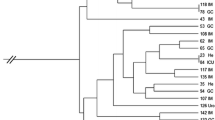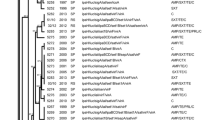Abstract
The antimicrobial resistance and the character of integrons were determined in 58 Shigella flexneri strains isolated from China. All isolates were multi-drug resistant and found to carry integrons of class 1 (94.8%), class 2 (100%), or both (94.8%). No intI3 was detected. The typical class 1 integrons were found in conjugative plasmids and could be transferred to the recipient E. coli DH5α. The gene cassettes of typical class 1 integrons dfrA17-aadA5 and dfrA12-orfF-aadA2 were detected in 54 strains (93.1%) and 1 strain, respectively. Atypical class 1 integrons located on the chromosome with gene cassettes bla oxa-30-aadA1 were detected in 55 isolates (94.8%). All the intI2 positive isolates carried gene cassettes dfrA1-sat1-aadA1. To our knowledge, this is the first report that atypical and typical class 1 integrons coexisted with class 2 integron in multi-drug resistant S. flexneri strains.
Similar content being viewed by others
References
Collis CM, Hall RM (1992) Site-specific deletion and rearrangement of integron insert genes catalyzed by the integron DNA integrase. J Bacteriol 174:1574–1585
Dubois V, Parizano MP, Arpin C et al (2007) High genetic stability of integrons in clinical isolates of Shigella spp. of worldwide origin. Antimicrob Agents Chemother 51:1333–1340
Gassama-Sow A, Diallo MH, Boye CS et al (2006) Class 2 integron-associated antibiotic resistance in Shigella sonnei isolates in Dakar, Senegal. Int J Antimicrob Agents 27:267–270
Koplan JP, Hughes JM, Cohen ML et al (1999) Laboratory methods for the diagnosis of epidemic dysentery and cholera. WHO/CDS/CSR/99.8. Centers for Disease Control and Prevention, Atlanta, GA
Kotloff KL, Winickoff JP, Ivanoff B et al (1999) Global burden of Shigella infections: implications for vaccine development and implementation of control strategies. Bull World Health Organ 77:651–666
Luck SN, Turner SA, Rajakumar K et al (2001) Ferric dicitrate transport system (Fec) of Shigella flexneri 2a YSH6000 is encoded on a novel pathogenicity island carrying multiple antibiotic resistance genes. Infect Immun 69:6012–6021
Lv RL, Duan GC, Xi YL et al (2008) Analysis on mar gene mutation in multi-drug resistant Shigella. Chin J Microbiol Immunol 28:208–211
Marquez C, Labbate M, Raymondo C et al (2008) Urinary tract infections in a South American population: dynamic spread of class 1 integrons and multidrug resistance by homologous and site-specific recombination. J Clin Microbiol 46:3417–3425
Navia MM, Gascon J, Vila J (2005) Analysis of the mechanisms of resistance to several antimicrobial agents in Shigella spp. causing travellers’ diarrhoea. Clin Microbiol Infect 11:1044–1047
Oh JY, Yu HS, Kim SK et al (2003) Changes in patterns of antimicrobial susceptibility and integron carriage among Shigella sonnei isolates from southwestern Korea during epidemic periods. J Clin Microbiol 41:421–423
Pan JC, Ye R, Meng DM et al (2006) Molecular characteristics of class 1 and class 2 integrons and their relationships to antibiotic resistance in clinical isolates of Shigella sonnei and Shigella flexneri. J Antimicrob Chemother 58:288–296
Pazhani GP, Niyogi SK, Singh AK et al (2008) Molecular characterization of multidrug-resistant Shigella species isolated from epidemic and endemic cases of shigellosis in India. J Med Microbiol 57:856–863
Peirano G, Agerso Y, Aarestrup FM et al (2005) Occurrence of integrons and resistance genes among sulphonamide-resistant Shigella spp. from Brazil. J Antimicrob Chemother 55:301–305
Ploy MC, Denis F, Courvalin P et al (2000) Molecular characterization of integrons in Acinetobacter baumannii: description of a hybrid class 2 integron. Antimicrob Agents Chemother 44:2684–2688
Ranjbar R, Aleo A, Giammanco GM et al (2007) Genetic relatedness among isolates of Shigella sonnei carrying class 2 integrons in Tehran, Iran, 2002–2003. BMC Infect Dis 7:62
Shibata N, Doi Y, Yamane K et al (2003) PCR typing of genetic determinants for metallo-beta-lactamases and integrases carried by gram-negative bacteria isolated in Japan, with focus on the class 3 integron. J Clin Microbiol 41:5407–5413
Sivapalasingam S, Nelson JM, Joyce K et al (2006) High prevalence of antimicrobial resistance among Shigella isolates in the United States tested by the National Antimicrobial Resistance Monitoring System from 1999 to 2002. Antimicrob Agents Chemother 50:49–54
Talukder KA, Khajanchi BK, Islam MA et al (2004) Genetic relatedness of ciprofloxacin-resistant Shigella dysenteriae type 1 strains isolated in south Asia. J Antimicrob Chemother 54:730–734
Wang XY, Tao F, Xiao D et al (2006) Trend and disease burden of bacillary dysentery in China (1991–2000). Bull World Health Organ 84:561–568
White PA, McIver CJ, Rawlinson WD (2001) Integrons and gene cassettes in the enterobacteriaceae. Antimicrob Agents Chemother 45:2658–2661
Yang H, Duan G, Zhu J et al (2008) The AcrAB-TolC pump is involved in multidrug resistance in clinical Shigella flexneri isolates. Microb Drug Resist 14:245–249
Zhao S, White DG, Ge B et al (2001) Identification and characterization of integron-mediated antibiotic resistance among Shiga toxin-producing Escherichia coli isolates. Appl Environ Microbiol 67:1558–1564
Zhu JY, Duan GC, Xi YL (2004) Study on the molecular mechanism of quinolone resistance in Shigella spp. Chin J Epidemiol 25:245–247
Acknowledgments
This study was supported by the Research Fund from Ministry of Health of the People’s Republic China, WKJ2007-2-024.
Author information
Authors and Affiliations
Corresponding author
Electronic Supplementary Material
Below is the link to the electronic supplementary material.
Rights and permissions
About this article
Cite this article
Zhu, J.Y., Duan, G.C., Yang, H.Y. et al. Atypical Class 1 Integron Coexists with Class 1 and Class 2 Integrons in Multi-Drug Resistant Shigella flexneri Isolates from China. Curr Microbiol 62, 802–806 (2011). https://doi.org/10.1007/s00284-010-9790-3
Received:
Accepted:
Published:
Issue Date:
DOI: https://doi.org/10.1007/s00284-010-9790-3




